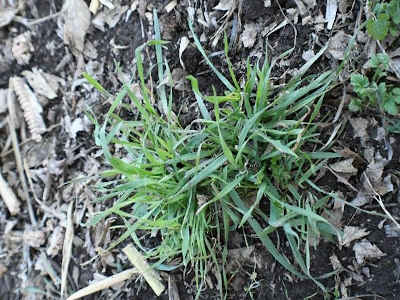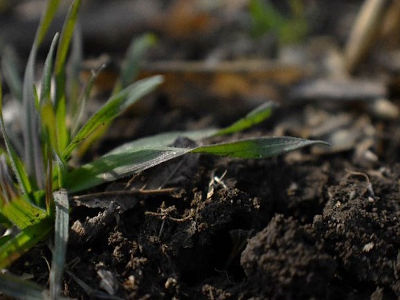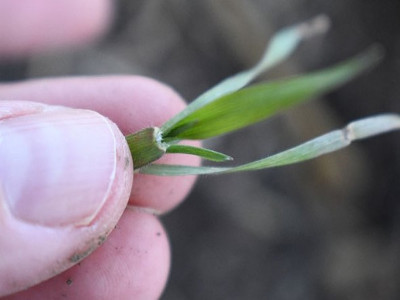By Sarah Lancaster
Fall is a good time to control weedy brome species, such as downy brome. This article will discuss some identifying characteristics of downy brome, as well as control measures.
Ecology of downy brome
Downy brome (Bromus tectorum) is native to the Mediterranean area and was introduced to New York and Pennsylvania during the late 1800’s. It can be found throughout Kansas in upland settings, often in over-grazed pastures. Downy brome is a winter annual grass that typically emerges in the fall, but can also emerge in early spring (Figure 1). It produces seeds in late spring and is typically the first of the common weedy bromes to flower in spring.

Figure 1. Downy brome fall growth habit. Photo by Sarah Lancaster, K-State Research and Extension.
Identification
Key identifying features of downy brome and other weedy brome species are shown in Table 1. Seedling leaves have a clockwise twist and are covered with soft hairs (Figure 2). The closed sheath is also covered with soft hairs. The ligule is a fringed membrane (Figure 3). Mature plants can reach up to 2 feet tall with leaves up to 5 inches long. Mature leaves also have long short hairs on both surfaces. Downy brome produces and extensive root system that reaches up to 4 feet deep and is very efficient at withdrawing water from the soil.
Table 1. Identifying features that distinguish among downy brome, Japanese brome, and cheat.
Downy Brome
| Japanese Brome | Cheat |
Leaf surface | Soft, short hairs on both surfaces | Soft hairs on both surfaces | Occasional hairs |
Sheath | Hairy | Hairy | Hairless to occasional hairs |
Ligule | Fringed membrane | Fringed membrane, slightly pointed | Fringed membrane |
Spikelet | Long awns (0.75 inches) | Awns slightly bent | Short awns (.4 inches) |

Figure 2. Downy brome leaf – note the clockwise twist and hairs. Photo by Sarah Lancaster, K-State Research and Extension.

Figure 3. Downy brome ligule. Photo by Sarah Lancaster, K-State Research and Extension.
The inflorescence in an open, droopy panicle about 7 inches long. Each spikelet contains 4-8 seeds. Spikelets are tipped with an awn approximately 0.75 inches long. The awns facilitate seed dispersal by attaching to animals’ coats and may cause injury to the mouths and eyes of grazing animals.
Management
There is some evidence that once established in a native area, downy brome cannot be dislodged. However, it is possible to control downy brome in winter annual crops such as wheat or canola. Control in wheat is critical, as data suggest that downy brome infestations of approximately 9 plants per square foot can reduce wheat yields 20 to 40%.
Few herbicides labeled for winter wheat will provide excellent control of downy brome. However, fall applications of herbicides such as Olympus, Outrider, or PowerFlex generally provide greater suppression than spring applications. Acceptable control of downy brome can be achieved by planting Clearfield or CoAxium varieties and applying Beyond or Aggressor, respectively.
Controlling downy brome in rotational crops is an excellent integrated management strategy. For example, grass weeds are more easily controlled in winter canola or with fall or early spring applications of glyphosate before planting a summer crop.
Source : ksu.edu